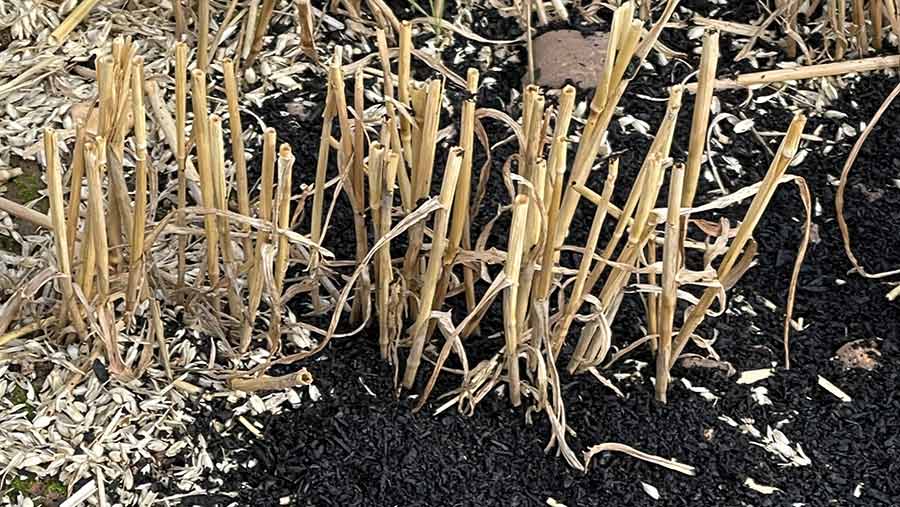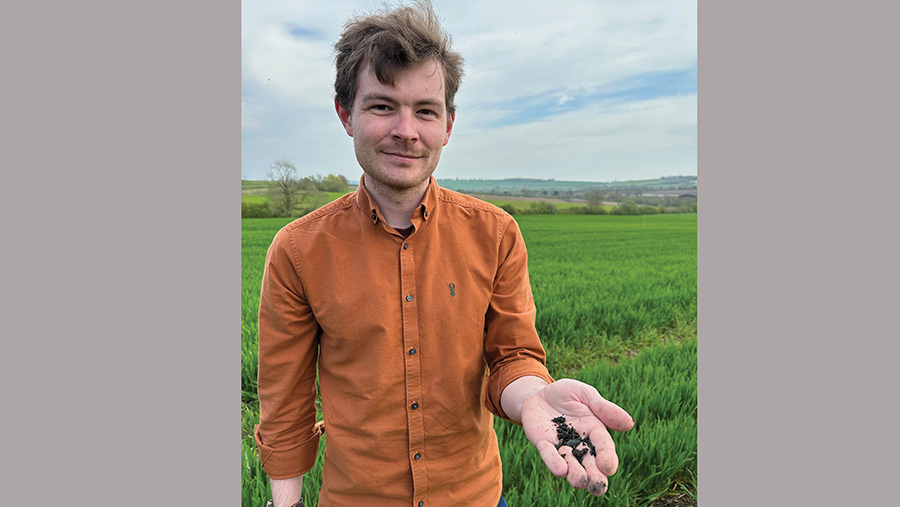Can climate change champion biochar match its potential?
 © University of Nottingham
© University of Nottingham Soil improver, waste recycler and atmospheric carbon capturer – there’s a lot of excitement about the potential benefits of biochar. Equally, there are a lot of unknowns about whether that potential will be realised in practice.
Produced from heating organic biomass to very high temperatures under low oxygen conditions by a process called pyrolysis, biochar is a carbon-rich charcoal-like substance, which can be used to store carbon dioxide taken from the atmosphere by plants.
See also: How natural fungi can be encouraged to aid crop production
That opens the possibility for its use in climate change mitigation strategies, says Joe Stanley, head of training partnerships at the Allerton Project, which is one of the field trials sites for a £4.5m Biochar Demonstrator project.
“Biochar obviously has potential and there are lots of claims around its use, but it’s difficult to pin down the reality and the science,” he notes.
The Biochar Demonstrator project is one of five greenhouse gas removal projects funded by UK Research and Innovation to explore the effectiveness, cost, risks and limitations of large-scale greenhouse gas removal.
Dr Catherine Price is a researcher on the project from the University of Nottingham, she explained:
“We’re conducting a comprehensive biochar demonstration programme deploying over 200t of biochar to arable fields, grassland, woodland and contaminated land.”
Biochar generally comes in a smaller particulate form, rather than lumps as with some charcoal, meaning it can be surface distributed through a lime spreader.
It can also potentially be mixed with farmyard manure or compost and applied by a muck spreader, ideally before cultivation or crop establishment.
Particle size shouldn’t be too fine to avoid dust issues with applications and avoid any risk of reducing soil porosity and creating drainage issues.
Incorporation either by ploughing or discing reduces any wind or water erosion risks, although that offsets some of the potential carbon removals.
Biochar is really a low-grade activated carbon, explains project lead Prof Colin Snape from the University of Nottingham.
“It can absorb nutrients, moisture and even pull contaminants such as heavy metals from soils. There are benefits in reduced nitrous oxide emissions from soils and also for soil microbes.
Less fertiliser
“Potentially it could also reduce fertiliser use, which has a knock-on effect for greenhouse gas removals as the emissions associated with fertiliser production are huge.”
That’s because once in the soil biochar potentially could act as a fertiliser releasing nutrients, or like lime, explains Dr Tom Bott, a soil scientist and microbiologist at the University of Nottingham.
Biochar with larger particle sizes might help with soil structure, such as by improving porosity and water holding capacity, or reducing compaction.
“Those effects, which will be dependent on the biochar and soil type, could result in higher yields for the farmer and healthier soils.
“At the same time, we’re locking carbon up, which could help obtain net zero on that farm and/or provide opportunities for carbon trading.”
However, research in UK conditions to prove those effects is limited, so the Biochar Demonstrator aims to rectify that using a stable biochar created from a woody feedstock.
This is pyrolysed at a high temperature to maximise carbon sequestration and greenhouse gas removal.

Dr Tom Bott © Mike Abram
There are three scales of trials – greenhouse pots, small scale field plots, and larger field-scale 1ha blocks.
The controlled condition greenhouse trials are investigating the interactions between biochar and nutrient and pesticide applications, water holding capacity and effects on soil microbiology.
“For example, we’re trying to understand if there is increased carbon dioxide release by creating a priming effect from stimulating the soil microbiology in the first six months, and immediately temporarily losing some of the carbon you’ve added to the soil.”
Small plot field trials are researching the longer-term effects of applying 10t/ha biochar to two different soil types.
These trials will also look at repeat applications in subsequent years and co-applications of compost and biochar.
The 1ha blocks on arable, pasture and forestry sites are examining scalability and practical implications, such as ease of application.
Both types of field trials will be yielded with various soil and plant samples taken for other analysis to build a picture of what biochar offers, Dr Bott adds.
He hopes the trials can answer some key practical questions around how much is too much, nutrient and pesticide lock-up, and fertiliser use.
“For example, will any extra fertiliser be required, at least initially, to overcome absorptive effects of biochar, and can you reduce fertiliser use after three or four years as the biochar starts to slow-release nutrients back into the soil?”
Soil protection
Other areas of interest include whether its use helps protect soils against drought and frost, or encourages early germination and faster growth through capturing more sunlight in the dark material and warming soils.
Dr Bott is confident biochar will help improve soil health, soil structure, water holding capacity and have a positive effect on pH, but says it is important to understand the effects will depend on the biochar feedstock, pyrolysis temperature and soil type.
“If we have a very nutrient-rich feedstock, such as biosolids or chicken manure pyrolysed at 400C, we end up with a biochar that’s much more likely to act as a fertiliser and add nutrients to the soil.
However, it’s going to be much less stable and more likely to break down over tens of years and not as useful for carbon sequestration.
“At the other extreme, if we pyrolyse wood at 800C the biochar will have a much lower nutrient concentration but will be much more stable, potentially lasting for hundreds, if not thousands of years in the soil, and better at sequestering carbon.
“That leads to the question is there a right biochar for certain soils and uses. Is a clay soil going to be better off having biochar made in a particular way from a certain feedstock for what that farm needs?”
The field trials will last until 2025 with a further three years of monitoring by researchers to look at longer term effects, he concludes.
How is biochar regulated?
Biochar production from waste is regulated under low risk waste position 60 (LRWP).
This limits the sources of waste from which biochar can be produced, storage of waste to 30t, and a maximum throughput to produce biochar of 50kg/hour.
LRWP 61 applies for storing and spreading biochar to land.
Again, it defines what feedstocks can be used to produce the biochar, limits the amount of storage of the final biochar product to a maximum of 10t and for up to 12 months before spreading.
Only 1t/ha can be applied in any 12-month period.
Biochar must be stored and spread at least 10m from any watercourse and 50m from any spring, well or borehole.
It must also not be spread on land that has been frozen for more than 12 hours in the preceding 24 hours, or is waterlogged, frozen or covered in snow.
Those restrictions are aimed at invoking minimal risk and avoiding any unintended consequences from biochar use.
This is particularly as it is being used on crops entering the food chain and because once it is spread on land it’s impossible to remove, Prof Snape says.
“Clearly using 10t/ha in the demonstrator trials is deliberately going way beyond that limit using a one-off dispensation.”
Applying just 1t/ha of biochar to the approximately 6m ha of arable land in the UK would only remove 3-4m tonnes of carbon from the atmosphere, he calculates.
“That’s not a huge amount against the UK target of around 20m tonnes of carbon removal a year by 2050, so that was part of our reason for pushing the limit up.”
Biochar research suggests higher benefits in tropical climates
Much of the research on biochar has been carried out in tropical climates, where soils are typically sandy, degraded and acidic.
“A lot of the good results with biochar have come in these soils, and it’s unlikely the benefits in UK soils will be the same,” Dr Bott says.
Indeed a 2015 meta-analysis of 109 studies comparing biochar use in tropical and temperate climates found a positive effect on yields in tropical climates, but none in temperate climates.
Nutrient-rich feedstock biochar had the greatest effect on yields in the tropics, but again little or no impact in temperate climates.
“But in soils of pH seven or below irrespective of region there was a positive impact on yield,” Dr Bott notes.
Case study: Simon Watchorn, Park Farm, Earsham, Norfolk

Simon Watchorn © Tim Scrivener
Initial observations at Simon Watchorn’s Park Farm, Earsham, about the use and impact of biochar have been positive.
He has two 1ha plots as part of the Biochar Demonstrator project .
One where the biochar was spread on sandy clay loam soils between two wheat crops, the other on lighter soil between two maize crops.
The biochar arrived in 1t bags, but while wet it wasn’t lumpy and spread well, Mr Watchorn says.
“Because it was a trial we went to quite a lot of effort to get an even spread over the hectare, and actually spread the hectare twice, splitting the wheelings, to get an even spread. We reckon it was spreading it around 8m.”
While the spreader would hold around 8t of lime, they only managed to fit in two bags of biochar, which made the process slow, although it came out of the bag easily.
“If you were doing a whole field, I like the idea of mixing it with farmyard manure and putting it on with a muck spreader. I can spread 20-25t/ha in one pass and we’ll get good cover.”
Application to the maize field was late, he says, with a cover crop planted towards the end of September to mop up nutrients in the soil.
The field used to house a 600-sow breeding unit until last year, so phosphate indices are extremely high.
The maize crop struggled in a very dry year, leaving most of the applied nitrogen and residual nitrogen from the pigs still in the soil.
Frosts in December hit the cover crop hard, but where the biochar had been applied, it survived better and stood out visually, Mr Watchorn notes.
Similarly in the wheat field, satellite imagery by Soyl taken to determine variable nitrogen applications highlighted the biochar treated area with more biomass in the middle of April.
“While usually you would switch the application for the last of three N applications to go for maximum yield, because the crops are forward, we’ve switched the second application to go for yield and applied quite a heavy second dose.
“I don’t know whether it will translate into more yield, but we will be able to map it at harvest and also take grain samples.”
The farm is located in the River Waveney catchment, which is designated as high risk for nitrate pollution.
So longer-term Simon hopes using biochar would allow him to cut or improve the efficiency of fertiliser use, especially nitrogen.
“I also have to look for other streams of income with our support payments reducing, and I think carbon could be one of those,” he concludes.
Is there a market for commercially produced biochar?
Producing biochar at scale isn’t without its difficulties, not least finding a market for the product, according to Liz Casely, managing director and co-founder of DarkBlack.
DarkBlack is a start-up which claims to be the UK’s first large-scale carbon credit producing biochar company.
Its Blackbird 3-train continuous pyrolysis machine was commissioned earlier this year and would currently cost £1.8m to purchase.
It is expected to produce 1,000t/year of biochar, equating to 3,000 carbon credits/year, when fully operational.
“We’ve already sold our first carbon credits, subject to verification by Puro earth.”
The company has used various feedstocks – oversized wood, coppice and pallet waste – although all have their drawbacks.
“We’re working to solve the issues so biochar can be made from biowaste rather than anything with a commercial value.”
But what has really surprised the company is the lack of a market for biochar.
“Everyone talks about it being black gold, having all this value, but nobody wants it – you can’t even give it away,” she says.
“It’s really difficult because you can only apply 1t/ha on a commercial basis, and farmers are nervous.”
It’s part of the reason why the firm is planning to develop smaller scale, fully automated, affordable, accessible biochar machines that can be situated on farm producing around 2.5t of biochar/day, equating to 5-7 carbon credits.
“We want to provide machines with a minimal upfront payment on a lease so it is risk-free for operators.
“As long as it is operated for minimum periods it will pay for itself through automatically generated and verified carbon credits that will pay the lease payments,” she explains.
“Farmers will also be able to generate an income from additional carbon credits.”
Potential agronomic benefits
- Reduced leaching of nitrogen into groundwater
- Reduced nitrous oxide emissions
- Improved soil fertility
- Moderating soil acidity
- Improved water holding capacity
- Increased number of beneficial soil microbes
- Decreased fertiliser use
Agronomic risks from biochar
- Reduction in soil-applied herbicide and pesticide efficacy
- Locking up nutrients
- Locking up microbial activity
- Wash off into watercourses
- Wind erosion of biochar dust
- Reduced yield
Greenhouse Gas Removals Demonstrators
- Peatland restoration
- Afforestation
- Biochar
- Enhanced rock weathering
- Perennial biomass crops

